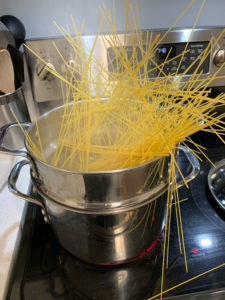Your great idea for a game just doesn’t work – even after hundreds of iterations. You’ve got a choice: stay (too) attached, or let it go. Here’s how to do the latter.
Designing a board game is incredibly fun. The process allows you to create your ideal game experience and explore innovative game mechanics. However, it’s inevitable that every game designer will come up with bad ideas that they think are amazing. If an idea doesn’t end up working out, it can be painful to cut it from a game – especially after spending hours working on it. Removing good ideas that don’t fit your current game is essential for great game design. We’ve found ourselves in this position all too often, and we’ve learned a few tricks to make that decision an easier one.
Embrace Failure

We weren’t attempting to play “Pick Up Sticks”, but even dinner prep can be a game.
When you create something new, you have an almost 100% chance of making a mistake. Board game design is no different: some solutions will create more problems, and the coolest idea isn’t always the best one. It can be easy to obsess over a new game mechanic and spend hours thinking about it until you’re sure it will work.
But you can never know for sure if something will work until you test it out. There’s no such thing as a first play test that goes perfectly. Being mentally prepared for failure will allow you to use the lessons you learn to make your game even better. And trust us, if you pay attention, there are always lessons to be learned.
Record Everything

You’re going to want a good way to keep track of your progress. The revisions add up fast.
One of the most freeing ways to design a board game is through the use of some revision tracker. Whether you’re using Google Drive or a box filled with old prototypes, keeping a record of your past game versions allows you to cut ideas without fear. If a mechanic isn’t working and you decide to try removing it, you can rest assured that if you decide later on to bring it back, you can do so without missing a beat. It also allows you to look at your past ideas when trying to solve a new problem, ensuring you don’t do the same work twice.
Think Bigger
While designing a board game, it’s easy to get wrapped up in the current problem you’re trying to solve. You’re creating an elegant solution that, in the end, doesn’t fit your game. As designers, we want to create amazing things. But we need to remember who we’re designing for.

Google ‘Think Bigger’.
Yeah, we thought there would be better options, too.
Creating board games is a difficult process and one that is filled with highs and lows. It can be difficult to cut an idea that you have poured your creative energy into. However, if you learn from your failures, leave a record of cut ideas, and remember the ultimate reason for even designing a board game, the pain of cutting a mechanic you love will be replaced with the joy of seeing your game get even better.
